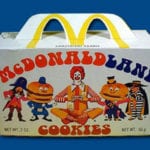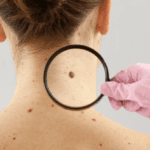 Mysteries
Mysteries  Mysteries
Mysteries  History
History 10 Surprising Stories About the Texas Rangers
 Humans
Humans 10 Philosophers Who Were Driven Mad by Their Own Theories
 Miscellaneous
Miscellaneous 10 Video-Game-Worthy Weapons and Armors from History
 Weird Stuff
Weird Stuff 10 Psychics Who Accurately Predicted Wartime Events
 The Arts
The Arts 10 Pieces of Art Inspired by a Broken Heart
 Health
Health 10 Science Fiction-Sounding New Medical Treatments
 History
History 10 Surprising Facts About the Father of Submarine Warfare
 Space
Space Ten Astonishing New Insights into Alien Worlds
 Weird Stuff
Weird Stuff 10 Bizarre Summer Solstice Rituals Still Practiced Today
 Mysteries
Mysteries Top 10 Haunting Facts About the Ghost Ship MV Alta
 History
History 10 Surprising Stories About the Texas Rangers
 Humans
Humans 10 Philosophers Who Were Driven Mad by Their Own Theories
Who's Behind Listverse?

Jamie Frater
Head Editor
Jamie founded Listverse due to an insatiable desire to share fascinating, obscure, and bizarre facts. He has been a guest speaker on numerous national radio and television stations and is a five time published author.
More About Us Miscellaneous
Miscellaneous 10 Video-Game-Worthy Weapons and Armors from History
 Weird Stuff
Weird Stuff 10 Psychics Who Accurately Predicted Wartime Events
 The Arts
The Arts 10 Pieces of Art Inspired by a Broken Heart
 Health
Health 10 Science Fiction-Sounding New Medical Treatments
 History
History 10 Surprising Facts About the Father of Submarine Warfare
 Space
Space Ten Astonishing New Insights into Alien Worlds
 Weird Stuff
Weird Stuff 10 Bizarre Summer Solstice Rituals Still Practiced Today
Top 10 Most Dangerous Things You Can Eat
Human beings have been moving about this planet for over 200,000 years, and in that time, we’ve put a lot of questionable things into our mouths. Many have died after eating poisonous or toxic plants and animals, only to ensure the safety of others who didn’t follow suit.
10 Bizarre Origin Stories About Your Favorite Foods
You would think that by the 21st century, people would have a good understanding of what not to eat—and we do. That doesn’t mean people all over the world aren’t regularly betting their lives on these ten dangerous foods you can actually eat.
10 Blood Clams

You’re always going to be taking a risk whenever you ingest a filter feeder like clams, but the dangers tend to skyrocket where Blood Clams are concerned. These delightful little buggers get their name from the large amounts of hemoglobin in their blood, which makes it a dark red. Other species of clams have clear blood, so the difference is rather striking. Despite looking like a small, bloody monster, Blood Clams are a delicacy in many parts of the Indo-Pacific region, where they are found.
The concern with eating Blood Clams comes from the animal’s remarkable ability to filter up to 40 liters (10.5 gallons) of water each day. This is how the animal feeds itself, but it also ensures the clams will take in a wide range of bacteria and viruses, which aren’t safe to eat in any situation. In areas where the water is particularly filthy, Blood Clams harvested there can pass on Hepatitis A, E, dysentery, and typhoid. In Shanghai in 1988, over 300,000 people became violently ill from eating them, and 31 people died. It is estimated that 15% of people who eat Blood Clams pick up one infection or another.[1]
9 Elderberries
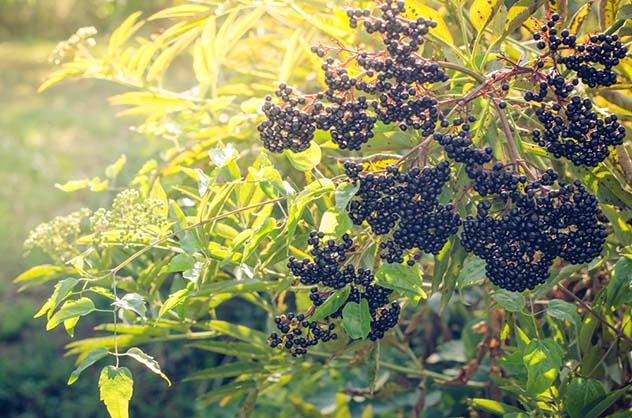
People all over the world enjoy Elderberries, so you might be wondering how they could possibly be dangerous. For the most part, the berries themselves are perfectly safe to eat, and because of this, they have been incorporated into everything from medicinal products to homeopathic remedies. They are also an excellent berry for making jam, and while most are perfectly safe to eat, some are incredibly harmful if ingested before they’re ripe or properly cooked.
Eating a raw, unripened Elderberry can result in severe diarrhea and seizures, which make them a particular danger to the young and elderly. Not that you would attempt to eat them purposefully, but the leaves, twigs, branches, roots, seeds, and flowers of the plant are highly toxic, containing large amounts of cyanogenic glycosides. If any of those elements wind up with the berries, you can expect to have a very bad day. Your safest bet when encountering these delicious berries in the wild is to leave them alone. If you’re not a botanist who can tell the difference between the safe berries and the dangerous ones, leave them on the plant.[2]
8 Pufferfish
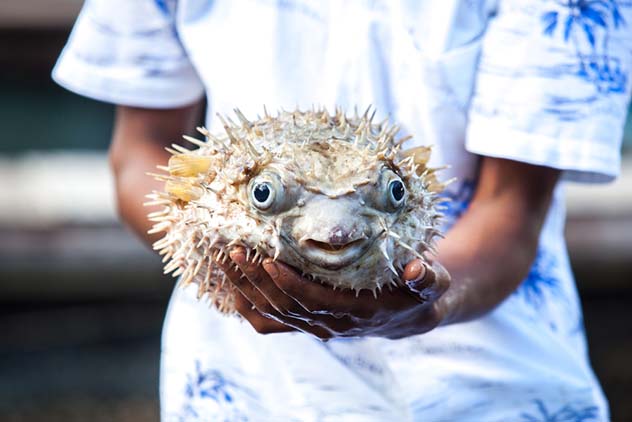
You know those adorable fish that inflate and have spines all over their bodies? Those little aquatic balls of fun can kill you, should you order it off a menu somewhere. The Japanese art of preparing the meat of the pufferfish, which is called Fugu, has long been a dangerous prospect for any sushi lover. Blowfish contain tetrodotoxin, which is a potent neurotoxin said to be 200 times deadlier to humans than cyanide. It is contained in the fish’s reproductive organs, liver, and intestines. Normally, you wouldn’t eat those parts of the fish, but that’s where the danger in preparation comes into play.
In order to serve Fugu, a Japanese sushi chef must undergo a licensing and training process that takes three years. Anyone who orders Fugu is made to understand just how deadly a slip of the chef’s knife can be, and they really do put their lives in the hands of that chef. If a minute amount of the tetrodotoxin makes its way into the meat, there’s little hope of surviving. First, you would feel numbness around the mouth, which would be quickly followed by paralysis, and ultimately, death, which can occur in 20 minutes, or as long as 24 hours later. Anyone dying from contaminated Fugu will remain conscious through the whole affair, which makes the pufferfish one of the deadliest fish you can eat.[3]
7 African Bullfrogs
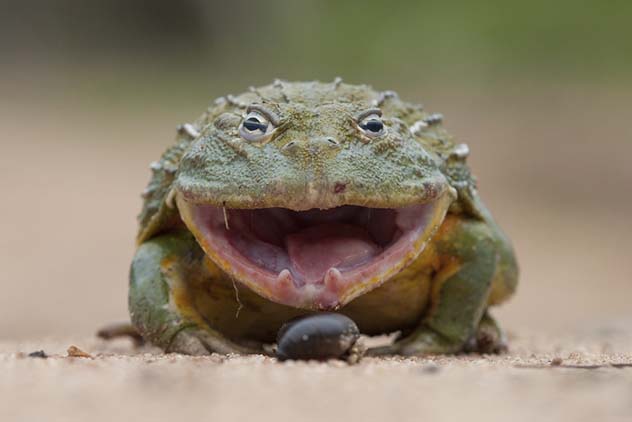
There are a lot of people in the Western world who scoff at the idea of consuming frogs, but in many parts of the world, frogs’ legs are a delicacy. You can find them everywhere from France to places all over the American Southeast. While that’s all well and good, there are some places in Africa where it’s common to eat the African Bullfrog, but they don’t stop at the legs. Instead, they ingest the entire frog, and that’s when eating these amphibians becomes dangerous to one’s health.
The consumption of the entire frog takes place throughout Africa but is mostly done in the country of Namibia, where it is considered a delicacy called “efuma.” In the eastern Luangwa Valley, the Nsenga people eat the frogs they call “kanyama kaliye fupam” which means, the animal without bones. The African Bullfrog’s skin and other organs contain harmful toxins, which can lead to kidney failure, and even death if ingested. Interestingly, a young frog that has yet to mate is far more lethal than older frogs, so it’s important to avoid eating them before the mating season begins.[4]
6 Nomura’s jellyfish

Nomura’s jellyfish, which is also known as Echizen Kurage, is a large species of jellyfish capable of growing up to two meters (6.6 ft) in length and weighing in at a whopping 200 kg (440 lbs.). Though they aren’t exactly prized in the fishing industry and are a dangerous invasive species, they are consumed in places like Japan, where it is considered a delicacy. Typically, jellyfish meat isn’t toxic, so long as you don’t eat the wrong parts, but that’s where consuming Echizen Kurage becomes a dangerous food. Unlike blowfish, the concern isn’t entirely about removing toxic parts; it’s about cooking the meat properly.
You cannot, under any circumstances, eat the meat of the Echizen Kurage raw. It must be cooked thoroughly, or you may find yourself ingesting toxic levels of the jellyfish’s nematocyst venom. Typical envenomation can result in itching, swelling, pain, and inflammation, but that changes if you ingest it. Doing so can lead to a painful death. Despite the deadly nature of the Echizen Kurage, it can be prepared safely with proper training. There’s even a company in Japan that produces a vanilla-flavored jellyfish ice cream made from the meat of the Echizen Kurage.[5]
5 Cashews
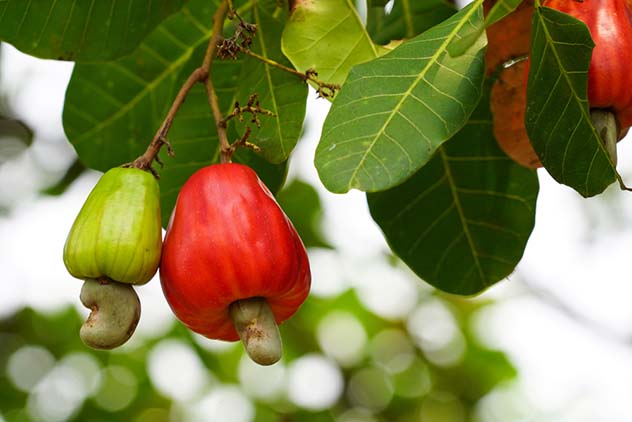
Pretty much anyone without a nut allergy has eaten handfuls of cashews at one time or another in their lives, but that doesn’t mean cashews can’t be harmful. When you buy “raw” cashews at the grocery store, you’re buying cooked nuts. The reason for this is, a raw cashew is not something you should ever put into your mouth. Raw cashews contain a chemical called urushiol, which is similar to the chemical found in plants like poison ivy and poison sumac. You wouldn’t eat anything with poison in its name, and you definitely shouldn’t eat raw cashews.
If you choose not to heed this warning, head out to the nearest cashew tree, and grab yourself some nuts; you need to be careful. One nut isn’t going to kill you, but enough can result in a lot of pain, which could end in your death. Granted, you would have to eat a lot of them, and you’d likely stop due to the painful irritation you would experience from ingesting them, but the danger is there. Fortunately, steaming raw cashews will remove the toxicity, which is how we are able to enjoy them en masse all over the world.[6]
4 Kæster Hákarl

For most people in the world, the idea of eating strips of fermented shark meat isn’t all that appealing, but the same cannot be said around Icelandic dinner tables. Kæster Hákarl, or simply Hákarl, is a traditional Icelandic dish made from the meat and skin of the Greenland shark. The problem arises from the fact that this particular species of shark lacks both a kidney and a urinary tract. Its waste has to go somewhere, so it does the only thing it can do; it filters its waste through its skin, which contains high levels of uric acid and trimethylamine oxide. This passes on all sorts of nightmare fuel into the skin and potentially onto the dinner plate.
Hákarl has been described by outsiders as “the single worst, most disgusting and terrible tasting thing” they had ever eaten. In order to make the meat remotely palatable and safe to ingest, it has to be fermented and hanged to dry for six months. Any less, and you run the risk of passing on any of a number of foodborne illnesses derived from ingesting the animal’s waste and natural toxicity. Typically, eating Hákarl is perfectly safe, albeit arguably disgusting, but it can make people sick on occasion. Death can only occur if it isn’t properly fermented, but there’s little worry of that happening these days.[7]
3 Ackee
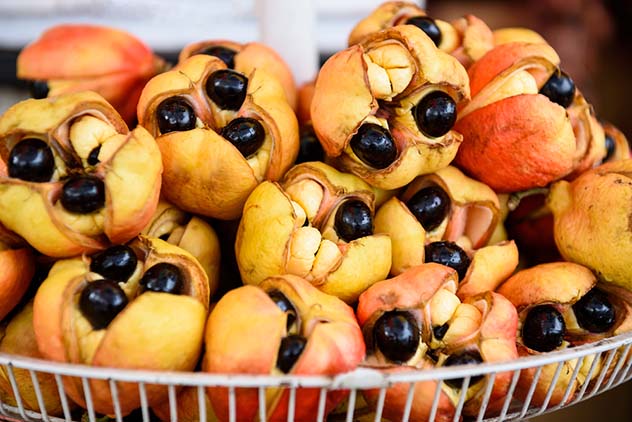
The national fruit of Jamaica isn’t going to be found in just any supermarket, as it contains a poison called hypoglycin. Ingesting the fruit before it has a chance to ripen fully will land you in the hospital if you’re lucky, and the morgue if you’re not. The fruit’s dangerous levels of hypoglycin can cause severe vomiting, which has come to be known as Jamaica Vomiting Sickness. This is the kind of vomiting that can become so frequent and horrifying; people can die from it. Nobody wants to vomit so much they die, but it has happened on occasion.
Fortunately, the fruit can be eaten; you just need to know when it’s safe to do so. The seeds are always toxic, so you never want to swallow them, but the flesh of the fruit can be enjoyed safely. This is only advisable when the fruit has naturally burst open—eating the yellow flesh beforehand will result in Jamaica Vomiting Sickness. Rarely, the condition can become so severe; a person can experience convulsions, delirium, toxic hepatitis, shock, and coma. Ackee fruit intoxication resulted in a number of deaths over the years, with 29 cases identified in 1988 and more than 50 in 2001.[8]
2 Live Octopus
Technically, most people don’t typically eat live octopus; they eat a recently killed octopus, which is a popular dish called San-nakji. This popular, yet frightfully disturbing delicacy found in Korea is a small baby octopus that has recently been killed. If you think that a dead animal can’t hurt you, you’ve never tried to eat San-nakji. The tentacles continue to wriggle after death, and when they come into contact with sesame oil, they violently jerk about, making the dish look as if it were alive. It’s fun to eat, but incredibly dangerous.
The problem with eating parts of an octopus containing suckers has to do with the fact that those suction cups still work when the tentacles are twitching. Swallowing it is a challenge, and while some connoisseurs get off on the sensation of having their food crawl up the back of their throats, many people die when their airway is blocked by a struggling tentacle. It’s estimated that as many as six people die every year from attempting to eat the delicacy, which makes it one of the deadliest items on this list.[9]
1 Cassava
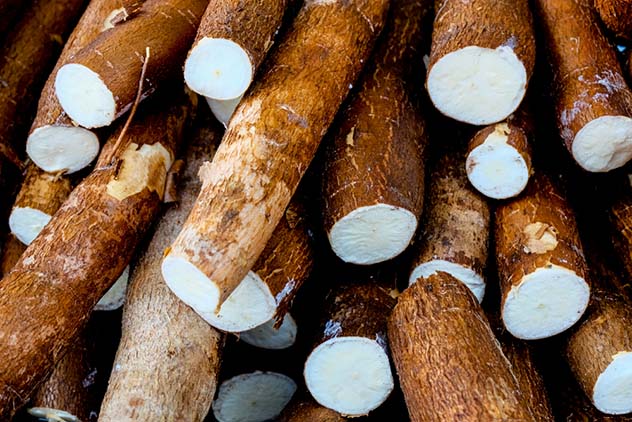
You may not know what Cassava is, but there’s a good chance you’ve eaten it at least once in your life. The tropical root crop is where tapioca comes from, so if you’ve ever had some tapioca pudding or boba tea, you’ve enjoyed a product from this plant. Fortunately, eating the plant is perfectly safe, just so long as you don’t do it when it’s still raw. If you eat it raw, you’re almost certainly going to poison yourself, as raw Cassava contains a toxin called linamarin. When linamarin enters your body, it converts into a deadly form of cyanide called cyanogenic glycoside.
That’s right, cyanide. One of the deadliest substances humans never want to come in contact with. Cassava plants are regularly processed for human consumption, and those products are perfectly safe. In less-developed parts of the world where the crop makes up a large portion of people’s diets, quick processing can result in toxic Cassava, and it has killed people numerous times over the years. In 2005, toxic Cassava resulted in the deaths of 27 children at a Philippine school. To properly process it, the roots have to be peeled, boiled, dried, soaked and rinsed. Raw Cassava should never be consumed, as it will certainly kill an average person.[10]
For more lists like this check out 10 Controversial Debates About Food And Cooking, and 10 Unfortunate Deaths Caused By Food
